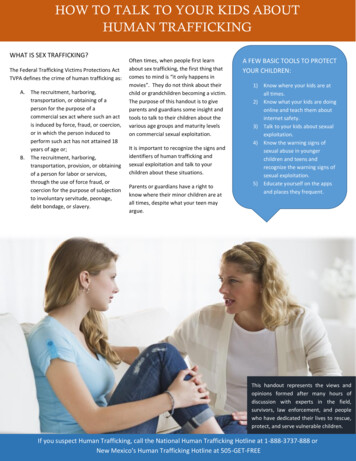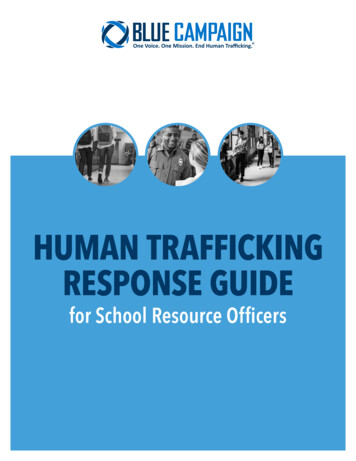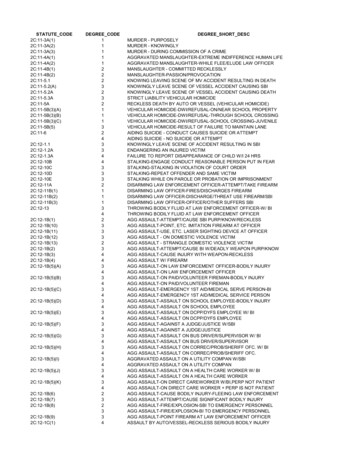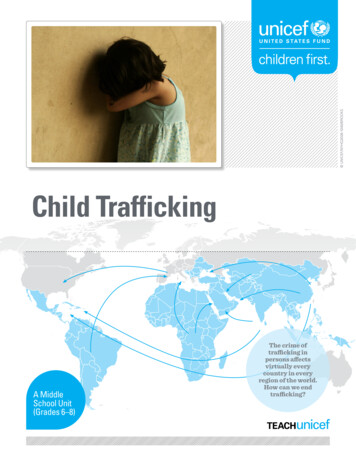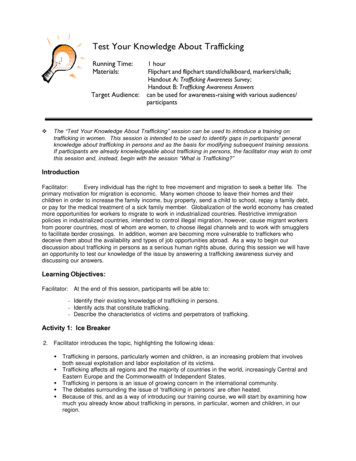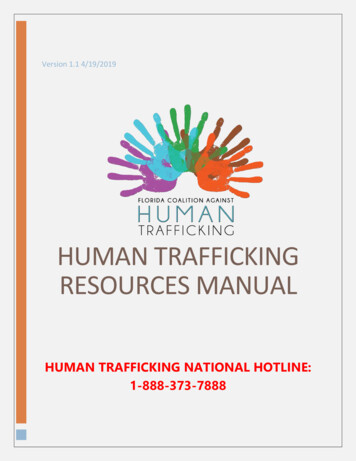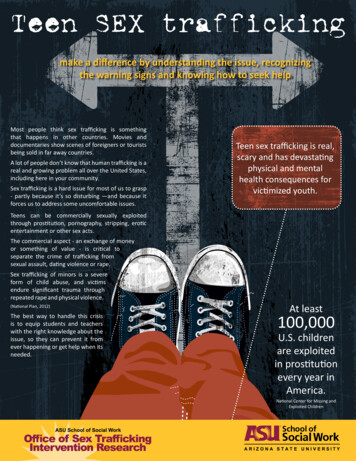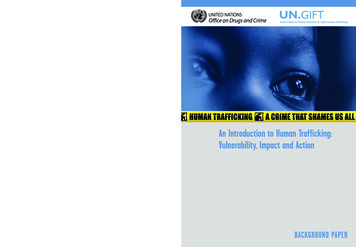
Transcription
Vienna International Centre, PO Box 500, 1400 Vienna, AustriaTel: (43-1) 26060-0, Fax: (43-1) 26060-5866, www.unodc.orgwww.ungift.orgPrinted in AustriaV.07-88925—January 2008—1,500An Introduction to Human Trafficking:Vulnerability, Impact and ActionBACKGROUND PAPER
UNITED NATIONS OFFICE ON DRUGS AND CRIMEViennaAn Introduction to Human Trafficking:Vulnerability, Impact and ActionUNITED NATIONSNew York, 2008
The designations employed and the presentation of material in this publication donot imply the expression of any opinion whatsoever on the part of the Secretariatof the United Nations concerning the legal status of any country, territory, city orarea or of its authorities, or concerning the delimitation of its frontiers orboundaries.
AcknowledgementsThis document was prepared by the United Nations Office on Drugs and Crime(UNODC). The effort was led by Kristiina Kangaspunta of the UNODC Anti-HumanTrafficking Unit, with the key papers researched and drafted by Michèle Clark, JudithDixon and Mike Dottridge. Valuable contributions were also made by Martin Fowke,Silke Albert, Riikka Puttonen, Troels Vester, Jonathan Eischen and Kerstin Uebel. Thereport was prepared under the overall leadership and supervision of Doris Buddenberg.For further information regarding the United Nations Global Initiative to Fight HumanTrafficking (UN.GIFT), please go to its website at www.ungift.org.The UNODC Anti-Human Trafficking Unit can be contacted at ahtu@unodc.org, telephone( 43-1) 26060-5687. For further information regarding UNODC’s work to combattrafficking in persons and the Protocol to Prevent, Suppress and Punish Trafficking inPersons, Especially Women and Children, supplementing the United Nations Conventionagainst Transnational Organized Crime, please go to www.unodc.org.iii
CONTENTSPageIntroduction . . . . . . . . . . . . . . . . . . . . . . . . . . . . . . . . . . . . . . . . . . . . . . . . . . . . . . . . . . . . . . . . . . . .1Summaries of the papers . . . . . . . . . . . . . . . . . . . . . . . . . . . . . . . . . . . . . . . . . . . . . . . . . . . . . . . .71. Vulnerability . . . . . . . . . . . . . . . . . . . . . . . . . . . . . . . . . . . . . . . . . . . . . . . . . . . . . . . . .72. Impact . . . . . . . . . . . . . . . . . . . . . . . . . . . . . . . . . . . . . . . . . . . . . . . . . . . . . . . . . . . . . . .83. Action . . . . . . . . . . . . . . . . . . . . . . . . . . . . . . . . . . . . . . . . . . . . . . . . . . . . . . . . . . . . . . .11Summaries of the papers (French) . . . . . . . . . . . . . . . . . . . . . . . . . . . . . . . . . . . . . . . . . . . . . . .151. Vulnerability . . . . . . . . . . . . . . . . . . . . . . . . . . . . . . . . . . . . . . . . . . . . . . . . . . . . . . . . .152. Impact . . . . . . . . . . . . . . . . . . . . . . . . . . . . . . . . . . . . . . . . . . . . . . . . . . . . . . . . . . . . . . .173. Action . . . . . . . . . . . . . . . . . . . . . . . . . . . . . . . . . . . . . . . . . . . . . . . . . . . . . . . . . . . . . . .19Summaries of the papers (Spanish) . . . . . . . . . . . . . . . . . . . . . . . . . . . . . . . . . . . . . . . . . . . . .231. Vulnerability . . . . . . . . . . . . . . . . . . . . . . . . . . . . . . . . . . . . . . . . . . . . . . . . . . . . . . . . .232. Impact . . . . . . . . . . . . . . . . . . . . . . . . . . . . . . . . . . . . . . . . . . . . . . . . . . . . . . . . . . . . . . .253. Action . . . . . . . . . . . . . . . . . . . . . . . . . . . . . . . . . . . . . . . . . . . . . . . . . . . . . . . . . . . . . . .Summaries of the papers (Chinese) . . . . . . . . . . . . . . . . . . . . . . . . . . . . . . . . . . . . . . . . . . . . .27331. Vulnerability . . . . . . . . . . . . . . . . . . . . . . . . . . . . . . . . . . . . . . . . . . . . . . . . . . . . . . . . .332. Impact . . . . . . . . . . . . . . . . . . . . . . . . . . . . . . . . . . . . . . . . . . . . . . . . . . . . . . . . . . . . . . .343. Action . . . . . . . . . . . . . . . . . . . . . . . . . . . . . . . . . . . . . . . . . . . . . . . . . . . . . . . . . . . . . . .36Summaries of the papers (Russian) . . . . . . . . . . . . . . . . . . . . . . . . . . . . . . . . . . . . . . . . . . . . .391. Vulnerability . . . . . . . . . . . . . . . . . . . . . . . . . . . . . . . . . . . . . . . . . . . . . . . . . . . . . . . . .392. Impact . . . . . . . . . . . . . . . . . . . . . . . . . . . . . . . . . . . . . . . . . . . . . . . . . . . . . . . . . . . . . . .413. Action . . . . . . . . . . . . . . . . . . . . . . . . . . . . . . . . . . . . . . . . . . . . . . . . . . . . . . . . . . . . . . .44Summaries of the papers (Arabic) . . . . . . . . . . . . . . . . . . . . . . . . . . . . . . . . . . . . . . . . . . . . . .561. Vulnerability . . . . . . . . . . . . . . . . . . . . . . . . . . . . . . . . . . . . . . . . . . . . . . . . . . . . . . . . .562. Impact . . . . . . . . . . . . . . . . . . . . . . . . . . . . . . . . . . . . . . . . . . . . . . . . . . . . . . . . . . . . . . .553. Action . . . . . . . . . . . . . . . . . . . . . . . . . . . . . . . . . . . . . . . . . . . . . . . . . . . . . . . . . . . . . . .52PART ONE.VULNERABILITY . . . . . . . . . . . . . . . . . . . . . . . . . . . . . . . . . . . . . . . . . . . . . .59Vulnerability, preventions and human trafficking: the need for a new paradigmI.Introduction . . . . . . . . . . . . . . . . . . . . . . . . . . . . . . . . . . . . . . . . . . . . . . . . . . . . . . . . .59II.The current framework for prevention of trafficking . . . . . . . . . . . . . . . . . .62III.The purpose of a discussion on vulnerability . . . . . . . . . . . . . . . . . . . . . . . . .67IV.Vulnerability: a definition . . . . . . . . . . . . . . . . . . . . . . . . . . . . . . . . . . . . . . . . . . . .68A. Vulnerability and human trafficking . . . . . . . . . . . . . . . . . . . . . . . . . . . . . .68B. Conditions of vulnerability . . . . . . . . . . . . . . . . . . . . . . . . . . . . . . . . . . . . . . .71v
V.VI.Practical implications for a vulnerability-based programme for theprevention of trafficking . . . . . . . . . . . . . . . . . . . . . . . . . . . . . . . . . . . . . . . . . . . . .76Conclusion . . . . . . . . . . . . . . . . . . . . . . . . . . . . . . . . . . . . . . . . . . . . . . . . . . . . . . . . . .78PART TWO.IMPACT . . . . . . . . . . . . . . . . . . . . . . . . . . . . . . . . . . . . . . . . . . . . . . . . . . . . . . . .79The impact of trafficking in persons . . . . . . . . . . . . . . . . . . . . . . . . . . . . . . . . . . . . . . . . . .81I.Introduction . . . . . . . . . . . . . . . . . . . . . . . . . . . . . . . . . . . . . . . . . . . . . . . . . . . . . . . . .81II.The consequences of trafficking upon individuals . . . . . . . . . . . . . . . . . . . .82A. The physical impact of trafficking . . . . . . . . . . . . . . . . . . . . . . . . . . . . . . . .82B. HIV/AIDS . . . . . . . . . . . . . . . . . . . . . . . . . . . . . . . . . . . . . . . . . . . . . . . . . . . . . . .83C. Mental health impact . . . . . . . . . . . . . . . . . . . . . . . . . . . . . . . . . . . . . . . . . . . . .84D. Child victims . . . . . . . . . . . . . . . . . . . . . . . . . . . . . . . . . . . . . . . . . . . . . . . . . . . . .84E. Substance abuse . . . . . . . . . . . . . . . . . . . . . . . . . . . . . . . . . . . . . . . . . . . . . . . . .85F. Impact on behaviour . . . . . . . . . . . . . . . . . . . . . . . . . . . . . . . . . . . . . . . . . . . . .85G. Stigma . . . . . . . . . . . . . . . . . . . . . . . . . . . . . . . . . . . . . . . . . . . . . . . . . . . . . . . . . . .86H. Recovery . . . . . . . . . . . . . . . . . . . . . . . . . . . . . . . . . . . . . . . . . . . . . . . . . . . . . . . . .87The political implications of trafficking in persons . . . . . . . . . . . . . . . . . . . .88A. Shaping migration policies . . . . . . . . . . . . . . . . . . . . . . . . . . . . . . . . . . . . . . .88B. Border control . . . . . . . . . . . . . . . . . . . . . . . . . . . . . . . . . . . . . . . . . . . . . . . . . . .89C. Human rights . . . . . . . . . . . . . . . . . . . . . . . . . . . . . . . . . . . . . . . . . . . . . . . . . . . .89D. Regular migration: countries of destination . . . . . . . . . . . . . . . . . . . . . . .90E. Regular migration: source countries . . . . . . . . . . . . . . . . . . . . . . . . . . . . . . .91F. Management of the status of trafficked persons . . . . . . . . . . . . . . . . . . .92The economic impact of trafficking in persons . . . . . . . . . . . . . . . . . . . . . . .93A. The costs of trafficking . . . . . . . . . . . . . . . . . . . . . . . . . . . . . . . . . . . . . . . . . . .93B. Lost resources . . . . . . . . . . . . . . . . . . . . . . . . . . . . . . . . . . . . . . . . . . . . . . . . . . .94C. Remittances . . . . . . . . . . . . . . . . . . . . . . . . . . . . . . . . . . . . . . . . . . . . . . . . . . . . . .94D. The profits of organized crime . . . . . . . . . . . . . . . . . . . . . . . . . . . . . . . . . . .96V.The impact on the rule of law . . . . . . . . . . . . . . . . . . . . . . . . . . . . . . . . . . . . . . .98VI.Post-conflict situations . . . . . . . . . . . . . . . . . . . . . . . . . . . . . . . . . . . . . . . . . . . . . . .98VII.Global security . . . . . . . . . . . . . . . . . . . . . . . . . . . . . . . . . . . . . . . . . . . . . . . . . . . . . .99VIII.Conclusion . . . . . . . . . . . . . . . . . . . . . . . . . . . . . . . . . . . . . . . . . . . . . . . . . . . . . . . . . .100PART THREE. ACTION . . . . . . . . . . . . . . . . . . . . . . . . . . . . . . . . . . . . . . . . . . . . . . . . . . . . . . .101Responses to trafficking in persons: international norms translated into actionat the national and regional levels . . . . . . . . . . . . . . . . . . . . . . . . . . . . . . . . . . . . . . . . . . . .103III.IV.I.Translating international instruments into action . . . . . . . . . . . . . . . . . . . . .103A. Legislation . . . . . . . . . . . . . . . . . . . . . . . . . . . . . . . . . . . . . . . . . . . . . . . . . . . . . . .103B. Institutions to combat trafficking . . . . . . . . . . . . . . . . . . . . . . . . . . . . . . . . .105C. Learning what works: good practice . . . . . . . . . . . . . . . . . . . . . . . . . . . . . .105vi
II.III.IV.V.Working together . . . . . . . . . . . . . . . . . . . . . . . . . . . . . . . . . . . . . . . . . . . . . . . . . . . .106A. At the national level . . . . . . . . . . . . . . . . . . . . . . . . . . . . . . . . . . . . . . . . . . . . .106B. At the bilateral level between two States . . . . . . . . . . . . . . . . . . . . . . . . . .106C. At the regional level, involving several States . . . . . . . . . . . . . . . . . . . . .107D. At the international level . . . . . . . . . . . . . . . . . . . . . . . . . . . . . . . . . . . . . . . . .108Prosecution and law enforcement activities . . . . . . . . . . . . . . . . . . . . . . . . . . .110A. Identifying trafficked persons . . . . . . . . . . . . . . . . . . . . . . . . . . . . . . . . . . . . .111B. Interceptions at frontiers . . . . . . . . . . . . . . . . . . . . . . . . . . . . . . . . . . . . . . . . .111C. Increasing the effectiveness of prosecutions by usingvictim-friendly techniques . . . . . . . . . . . . . . . . . . . . . . . . . . . . . . . . . . . . . . . .112D. Mutual legal assistance to facilitate prosecutions . . . . . . . . . . . . . . . . . .113Prevention . . . . . . . . . . . . . . . . . . . . . . . . . . . . . . . . . . . . . . . . . . . . . . . . . . . . . . . . . . .114A. Prevention in areas of origin . . . . . . . . . . . . . . . . . . . . . . . . . . . . . . . . . . . . .114B. Interceptions of those in transit . . . . . . . . . . . . . . . . . . . . . . . . . . . . . . . . . .116C. Prevention in areas where trafficked persons are exploited . . . . . . . .117Protection and assistance . . . . . . . . . . . . . . . . . . . . . . . . . . . . . . . . . . . . . . . . . . . .120A. International standards on protection and assistance . . . . . . . . . . . . . .120B. Emergency assistance and medical care . . . . . . . . . . . . . . . . . . . . . . . . . .121C. Assessment of cases of trafficked adults and children, includingVI.VII.risk assessments . . . . . . . . . . . . . . . . . . . . . . . . . . . . . . . . . . . . . . . . . . . . . . . . .122D. Enabling victims of traffickers to recover and restart their lives . . .123The role of research . . . . . . . . . . . . . . . . . . . . . . . . . . . . . . . . . . . . . . . . . . . . . . . . .123A. Research reports on regional patterns and specific countries . . . . . .123B. Research about those already trafficked, identifying thecircumstances in which they were vulnerable to traffickers . . . . . . . .124C. Research about traffickers and the techniques they use . . . . . . . . . . .124D. Research on the numbers of trafficked persons . . . . . . . . . . . . . . . . . . .125E. Research to monitor, evaluate and assess the impact of preventionand rehabilitation efforts . . . . . . . . . . . . . . . . . . . . . . . . . . . . . . . . . . . . . . . . .126F. Research standards: The World Health Organization . . . . . . . . . . . . . .126Conclusion . . . . . . . . . . . . . . . . . . . . . . . . . . . . . . . . . . . . . . . . . . . . . . . . . . . . . . . . . .127vii
IntroductionThe Global Initiative to Fight Human Trafficking“The United Nations Global Initiative to Fight Human Trafficking (UN.GIFT) aims to mobilize state and non-state actors to eradicate human trafficking by: (a) reducing both the vulnerability of potential victims and the demand for exploitation in all its forms; (b) ensuring adequateprotection and support to those who fall victim; and (c) supporting the efficient prosecution ofthe criminals involved while respecting the fundamental human rights of all persons.“In carrying out its mission, UN.GIFT will increase knowledge and awareness on human trafficking; promote effective rights-based responses; build capacity of state and non-state actors, andfoster partnerships for joint action against human trafficking.”(UN.GIFT mission statement)OverviewThe widespread contemporary exploitation of men, women and children is unacceptableto people of conscience the world over. Traditional approaches to preventing traffickingin human beings, to protect and assist trafficked persons and bring criminals to justicehave had some small impact on the global phenomenon, but not enough. That even oneyoung person be denied the benefits of childhood, that one young woman be subjectedto the brutal humiliation of sexual exploitation and that one man become the slave of acruel taskmaster in another country are clear signals that we must renew both our resolveas well as our initiatives to protect those who are vulnerable.The United Nations Global Initiative to Fight Human Trafficking (UN.GIFT) was bornout of a renewed commitment by world leaders in the battle against human trafficking toend this crime, one of the most egregious violations of human rights in the world today.Formally launched in March 2007 by the United Nations Office on Drugs and Crime(UNODC), and made possible by a generous grant from the United Arab Emirates,UN.GIFT is a call to action, reminding Governments, civil society actors, the media, thebusiness community and concerned individuals of their common commitments to fighttrafficking in persons, and that this battle can not be fought, or won, alone. As at 4December 2007, 116 nations had ratified the Protocol to Prevent, Suppress and PunishTrafficking in Persons, Especially Women and Children, thereby providing a commonframework for international efforts. Only by joining forces, pooling knowledge, expanding the scope and number of stakeholders and cooperating across borders can we hopeto eradicate human trafficking. Acknowledging this need at all levels, UNODC continues1
to develop UN.GIFT in partnership with the International Labour Organization, theInternational Organization for Migration, the United Nations Children’s Fund, the Officeof the United Nations High Commissioner for Human Rights and the Organization forSecurity and Cooperation in Europe.Why UN.GIFT?UN.GIFT aims to advance action against trafficking in persons on many fronts, and itsobjectives include the following:1.To raise awareness—to tell the world that human trafficking exists and mobilizepeople to stop it.2.To strengthen prevention—to inform vulnerable groups and alleviate the factors thatmake people vulnerable to trafficking.3.To reduce demand—to attack the problem at its source by lowering incentives totrade and lowering demand for the products and services of exploited people.4.To support and protect the victims—to ensure housing, counselling, medical, psychological and material assistance, keeping in mind the special needs of women andchildren and people at risk, such as those in refugee camps and conflict zones.5.To improve law enforcement effectiveness—to improve information exchange ontrafficking routes, trafficker profiles and victim identification in order to dismantlecriminal groups and convict more traffickers. For those convicted, to ensure that thepunishment fits the crime.6.To implement international commitments—to ensure that international commitmentsare turned into national laws and practice by targeting technical and legal assistanceto countries in greatest need and improving monitoring of implementation.7.To enrich the database—to deepen global understanding of the scope and nature oftrafficking in persons by more data collection and analysis, better data-sharing, jointresearch initiatives and creating an evidence-based report on global trafficking trends.8.To strengthen partnership—to build up regional and thematic networks involving civilsociety, intergovernmental organizations and the private sector.9.To ensure resources—to attract and leverage resources for the sustainable funding ofprojects around the world committed to ending human trafficking.10.To strengthen Member States’ participation—to give Member States a strong senseof ownership in the process and create long-term momentum.2
The Vienna Forum to Fight Human TraffickingThe framework of UN.GIFT has allowed for a global conference, the Vienna Forum toFight Human Trafficking, to be held in the Austrian capital from 13 to 15 February 2008.The Forum is a unique opportunity to bring together representatives from Member States,United Nations entities, non-governmental and international organizations, the businesscommunity, academia, the public sector and civil society.The Vienna Forum is a visible step towards generating consolidated support and politicalwill behind the goals of the Global Initiative. The aims of the Forum are specifically toraise awareness of all forms of trafficking, to facilitate cooperation and partnerships amongparticipants, to take stock of progress made and to set the directions for follow-up measures to prevent and counter human trafficking. The Forum also provides for an assessment of the lessons learned regarding the dimensions of the issue and the current actiontaken in response to trafficking in persons. It allows for an open environment to enableall the parties involved to take practical steps within their spheres of action to fight humantrafficking.Vulnerability, impact and actionThe Vienna Forum is organized around three central themes, which reflect the key issuesthat need to be addressed in a comprehensive anti-trafficking strategy: Why does humantrafficking occur? What are the consequences? What measures might be taken in response?Within each theme, plenary sessions as well as workshops provide participants with theopportunity to explore each theme in greater detail, with the purpose of developing comprehensive intervention strategies and undertaking practical action.1.—Vulnerability: why does human trafficking happen?Human traffickers prey on people who are poor, isolated and weak. Issues such asdisempowerment, social exclusion and economic vulnerability are the result of policiesand practices that marginalize entire groups of people and make them particularlyvulnerable to being trafficked. Natural disasters, conflict and political turmoil weakenalready tenuous social protection measures. Individuals are vulnerable to being traffickednot only because of conditions in their countries of origin, however. The allure ofopportunity, the relentless demand for inexpensive goods and services and theexpectation of reliable income drive people into potentially dangerous situations wherethey are at risk of being exploited. The Vienna Forum will examine existing definitionsof and practices related to the prevention of trafficking and, by focusing on decreasingvulnerability, will broaden the strategic impact of existing prevention efforts.3
2. Impact: the human and social consequences ofhuman traffickingThe human and social consequences of trafficking are compelling. From the physical abuseand torture of victims to the psychological and emotional trauma, to the economic andpolitical implications of unabated crime, the impact on individuals and society is clearlydestructive and unacceptable.The Vienna Forum will explore the impact of human trafficking on the lives of individuals and their communities. Participants will share experiences and focus on the consequences of human trafficking to victims, including the violence they experience, theadverse health effects, the social stigmatization and the risk of revictimization.3. Action: innovative approaches to solvingcomplex problemsThe Trafficking Protocol provides a comprehensive strategic approach to combating trafficking in human beings. Implementation of the measures described in the Protocol,remains uneven however. A lack of clarity related to even basic terms and definitions,national political concerns and uncertainty regarding what measures work and what donot have contributed to a lack of systematic and consistent implementation, and sustainable action. Participants will be able to review major global anti-trafficking strategies andnational responses, sharing from their own experiences and identifying elements that constitute best practices.Background papersIn order to provide participants with a common starting point for debate and dialogue,UNODC commissioned the three following background papers, each addressing one ofthe major themes of the conference, and drafted by three leading anti-trafficking experts.The first paper, on vulnerability, challenges current working definitions of prevention andthe practical emphasis on public awareness as the primary tool to prevent the occurrenceof this crime. The author maintains that an expanded understanding of prevention toinclude the vulnerability of at-risk individuals and the fostering of an environment wherecrime cannot prosper will assist in the development of comprehensive preventionstrategies.The second paper, on the impact of trafficking, outlines the many areas where traffickingaffects our lives. The author includes discussions of the consequences of trafficking on4
the victims of the crime, as well as on our social, political and economic systems, describing both the reach and the complex and interlocking negative impact that human trafficking has at both the national and the global level.The third paper, on action, provides a detailed summary of government responses to trafficking since the adoption of the Trafficking Protocol in 2000. The author describes stateactions in the areas of prevention, protection and assistance, and prosecution and lawenforcement, offering a critique of different approaches and a call for an understandingof what constitutes good and best practices.The full papers—reproduced in English only—are preceded by summaries in all six officiallanguages of the United Nations.5
Summaries of the papers1.—VulnerabilityVulnerability, prevention and human trafficking:the need for a new paradigmCurrent practices in the prevention of trafficking in human beings are analysed in thispaper in order to understand why human trafficking continues to be identified as a growing phenomenon. Numerous prevention initiatives and considerable funding notwithstanding, a preliminary conclusion is that existing prevention practices do not reflect thecomprehensive approach embodied in definitions of the term “crime prevention” in general or in the illustrative definition of “prevention” in article 9 of the Protocol to Prevent,Suppress and Punish Trafficking in Persons, Especially Women and Children, supplementing the United Nations Convention against Transnational Organized Crime.“Prevention” as it has been conceptualized in normative frameworks is examined, as alsohow those frameworks have been narrowly implemented. Vulnerability, in particular thevulnerability of an individual in his or her social context, emerges as the missing link informulating well-developed policies and practices. Focus is placed on what constitutes vulnerability to trafficking as a prerequisite for the development of valid prevention programmes. New considerations are introduced as regards the development of strategicpolicies to prevent trafficking that are capable of addressing the real problems of vulnerable populations according to their own needs, in their own contexts.The author questions what is meant when experts describe human trafficking as a growing phenomenon, since any assessment of an increase in human trafficking is impossibleto quantify except in general terms. Reasons for this include differences in national definitions of the crime of trafficking, as well as of who constitutes a victim of trafficking,along with a lack of consistent, reliable and comparable data.Both crime prevention and reduction of vulnerability are valid approaches to combatinghuman trafficking. Each calls for different dynamics in policy and programme planning.A focus on vulnerability will enhance the human rights component of trafficking prevention policies. Traditional definitions of crime prevention can contribute to the enhancement of anti-trafficking policies by focusing on reducing elements of risk in theenvironment. Theoretically, prevention should therefore aim to eliminate trafficking beforeit occurs by reducing the factors that make individuals vulnerable to being trafficked.Basic principles of crime prevention, such as the inclusion of a broad community of stakeholders, the empowerment of vulnerable persons and the reduction of risk factors, are7
AN INTRODUCTION TO HUMAN TRAFFICKING: VULNERABILITY, IMPACT AND ACTIONintrinsic to the elaboration of what is meant by “prevention” given in article 9 of theTrafficking Protocol. Unfortunately, the implementation of those principles has been limited, with the predominant focus having been on the development of both large and smallpublic awareness campaigns directed towards potential victims of trafficking. Such programmes are developed on the premise that increased awareness of possible harm willhelp an individual to choose a different path. However, such programmes fall short becausethey fail to provide potential victims with an alternative course of action. If the emphasisof prevention programmes is placed exclusively on increasing the awareness of potentialvictims, prevention is limited. By failing to provide alternatives, such interventions placethe onus for prevention of exploitation on the individual him- or herself. Potentialvictims remain equally vulnerable before and after viewing posters, films and televisionadvertisements.The author stresses that successfully assisting vulnerable populations to protect themselvesfrom harm is not possible without an understanding of what makes them vulnerable toviolence, abuse and exploitation in the first place. Reframing the issue of preventionthrough a definition of vulnerability to abuse and exploitation will allow for a more consistent approach to preventing trafficking. While the broad concept of prevention existsas part of the normative framework of many countries, viewing prevention models in termsof their relationships to the social, cultural, economic and political vulnerability of certainpopulations or groups to being trafficked has been largely neglected in practice.Although used frequently in anti-trafficking discussions, the terms “vulnerable” and “vulnerability” have not been conclusively defined other than in a legal context. This paperincludes an analysis of several considerations in understanding vulnerability and providesa definition in which “vulnerability” refers to “a condition resulting from how individualsnegatively experience the complex interaction of social, cultural, economic, political andenvironmental factors that create the context for their communities”.Based on such considerations, indicators for conditions of vulnerability will need to bedeveloped in the following areas: children; gender; poverty; social and cultural exclusion;limited education; political instability, war and conflict; social, cultural and legal frameworks; movement under duress; and demand.Because most conditions causing vulnerability are systemic and the result of governmentenacted policies, it is the responsibility of States to ensure the protection of vulnerableindividuals in their midst.2.—ImpactThe impact of trafficking in personsThe impact and cost of human trafficking on individuals as well as on political, economic and social systems is described in the paper. Human trafficking is a crime against8
SUMMARIES OF THE PAPERSindividuals and its consequences are most directly felt by those who are its victims. Whilehuman trafficking is a global phenomenon that knows no international borders, it is within individual countries and societies that its far-reaching and pervasive consequences arefelt. More than 130 countries are affected by human trafficking. Some of the most notablesocial, political a
Vienna International Centre, PO Box 500, 1400 Vienna, Austria Tel: (43-1) 26060-0, Fax: (43-1) 26060-5866, www.unodc.org Printed in Austria V.07-88925—January 2008—1,500
